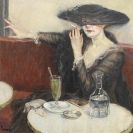
Carl Schuch
1846 Wien
1903 Wien
Carl Schuch was born son of an upper class family in Vienna in 1846. His parents owned the inn ‘Gasthof Zum Goldenen Pfau‘ in Leopoldtsadt, the 2nd municipal District of Vienna, as well as several coffeehouses all over Vienna. His family‘s wealth granted Carl Schuch financial independence throughout his entire life. Schuch decided to become a painter at the young age of thirteen and had first lessons in painting. As of 1865 he studied at the Vienna Academy of Fine Arts under Karl Wurzinger and Karl Mayer. In 1867 he became an apprentice to the Viennese landscape painter Ludwig Halauska. In 1869 Carl Schuch‘s sister Pauline died, an event that led Carl Schuch to leave Vienna and to embark on restless wanderings that would eventually take him through most of Europe for more than 25 years. In most cases he stayed no longer than three months in one place. Schuch did not return to Vienna before 1894.
In 1869/70 Schuch went on a journey through Italy for one year with the painter Albert Lang whom he had become acquainted with in Venice. Together they visited Palermo, Monreale, Agrigent, Syracus, Rom, Olevano and Florence, both executing scores of sketches. In 1871 Carl Schuch went to Munich where he met Wilhelm Trübner, who, even though he was four years younger, would become Schuch‘s most influential teacher and inspirer. In summer 1871 Schuch, Trübner and Lang went on trips to Lake Starnberg, Bernried and Walchensee, in order to paint in front of nature. This was also where he met Wilhelm Leibl who would convince the three artists to share a studio in Munich with him.
In summer 1873 Carl Schuch visited Hintersee near Berchtesgaden and met Karl Hagemeister with whom he traveled to Vienna and Dresden. Apart from the New Masters Gallery, a visit to to the collection of the Russian merchant Meyer was of utmost relevance for Carl Schuch, as it was the first time that he saw works by Eugène Delacroix, Camille Corot, Charles-François Daubigny and Théodore Rousseau. The two painters continued their journey and went to Brussels, where they shared a studio for some time. They also used the studio as basis for many trips to Antwerp, The Hague, Rotterdam and Amsterdam.
The year 1876 was of crucial importance for the development of Carl Schuch‘s work. He broke with his artist friend Wilhelm Trübner, as Schuch feared his impact on the own artistic creation might become too strong. 1876 was also the year that Carl Schuch began to paint still lifes, a genre that would characterize his entire late period of creation; in spring the same year he showed his first apple still life at the Kunstverein in Munich. From 1882-1894 he had a studio in Paris but also continued going on trips, spending the summer month in the surroundings of the waterfall Saut du Doubs near the French-Swiss border. The years in Paris saw the heyday of Carl Schuch‘s still life painting. He noted in his diary that he was intensively occupied with the art of French painters like Camille Corot, Gustave Courbet, Edouard Manet or Claude Monet.
First signs of a severe disease began to show in the early 1890s, be 1894 the undiagnosed illness had progressed to a point where Carl Schuch had to give up almost all artistic activity.
During his lifetime Carl Schuch‘s acclaim as painter was largely limited to his closer friends, owing to financial independence he did not have to rely on sales and exhibitions as sources of income. His accomplishments were only acknowledged after his death, when the two Berlin art traders Eduard Schulte and Karl Haberstock showed his work at the instance of his wife and Wilhelm Trübner. Today Carl Schuch is considered Austria‘s most important painter on the eve of Impressionism. In 1903 Carl Schuch died in his hometown Vienna.
Related artists: Barlach, Ernst | Baum, Paul | Bonnard, Pierre | Bürkel, Heinrich | Caspar-Filser, Maria | Cavael, Rolf | Chelminski, Jan | Compton, Edward Theodore | Corinth, Lovis | Corot, Jean-Baptiste-Camille | Cucuel, Edward | Daubigny, Charles-Francois | Defregger, Franz von | Diefenbach, Karl Wilhelm | Dill, Otto | Gauguin, Paul | Grützner, Eduard von | Hackert, Jacob Philipp | Hagemeister, Karl | Heine, Thomas Theodor | Hess, Peter von | Hofmann, Ludwig von | Israëls, Jozef | Jutz, Carl, the elder | Klee, Paul | Klinger, Max | Koester, Alexander | Kollwitz, Käthe | Kuhnert, Friedrich Wilhelm | König, Leo von | Leistikow, Walter | Liebermann, Max | Manet, Edouard | Max, Gabriel Cornelius von | Menzel, Adolph von | Meyer von Bremen, Johann Georg | Modersohn, Otto | Mucha, Alphonse | Mulley, Oskar | Munch, Edvard | Oppenheimer, Max | Overbeck, Fritz | Palmié, Charles Johann | Paolozzi, Eduardo | Piloty, Karl Theodor von | Pippel, Otto | Pissarro, Camille | Putz, Leo | Raupp, Karl | Renoir, Pierre-Auguste | Repin, Ilya Yefimovich | Rodin, Auguste | Rugendas, Johann Moritz | Runge, Philipp Otto | Santomaso, Giuseppe | Schinkel, Karl Friedrich | Schleich d. J., Eduard | Steinlen, Théophile Alexandre | Stuck, Franz von | Thoma, Hans | Thöny, Eduard | Tischbein, Johann Heinrich Wilhelm | Toulouse-Lautrec, Henri de | Trübner, Wilhelm | Vogeler, Heinrich | Volkmann, Arthur | Wagenbauer, Max Joseph | Werner, Anton Alexander von | Wierusz-Kowalski, Alfred von | Wopfner, Joseph | Zügel, Heinrich von

Would you like to sell a work by Carl Schuch?
Infos for seller



